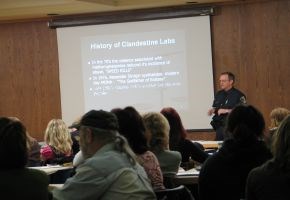BY MIKE SIMMS
Greater Sudbury Police hosted a three-hour presentation to raise awareness about the increase in clandestine drug labs being operated in Greater Sudbury at Cambrian College Tuesday.
The event was sponsored by the local chapter of the Elizabeth Fry Society. The workshop was part of the Elizabeth Fry Society's 4th Annual Professional Development Workshop Series Fundraiser.
Const. Bob Brunette and Sgt. Peter Orsino conducted a presentation on clandestine drug laboratories and Sudbury drug trends.
Brunette kicked off the conference with a five-minute video on methamphetamine or "meth" as it's often recognized on the street.
He focused on illegal drug labs, their history and the devastating effects on the individual drug abuser and the community.
"The worst drug in our community right now is crack cocaine," Orsino said. "However, the worst drug out there is methamphetamine."
Brunette focused on meth's huge comeback, especially in Ontario and western Canada. The drug usually shows up on the street in the form of Ecstasy with 60 per cent of clandestine labs controlled by biker gangs, he said.
Meth is highly addictive due to the tolerance users build up over time, he said.
Addicts require more of the drug every time in order to sustain the same level of intoxication. Meth comes in the form of a white, odourless powder and can be snorted, swallowed, smoked, or injected. It is often smoked in a pipe, much like crack cocaine, he said.
Orsino is the officer in charge of the police service's drug unit and was the second facilitator at the event. His focus was on the local drug scene, trends among users and the infiltration of crack cocaine into this community over the past two years.
"Right now, the epidemic that our city is facing is crack cocaine," Orsino said. "The other drugs remained constant, but crack cocaine is ever increasing."
Orsino gave four methods of how police plan to deal with drugs in the community. They include an increase in education programs, enforcement, reduction and longer rehabilitation programs.
"I think if we can get those four things going, that's the best we can do for now," said Orsino.
"This is part of the education. It puts the word out there, makes people more aware and hopefully when they see something they may be able to figure out what it is before it goes on too long."
According to the Centre for Addiction and Mental Health (CAMH), crack is more addictive than powder cocaine. Crack is made by a chemical change of powder cocaine and appears as crystals or rocks.
The rocks are usually no bigger than a stud earring and are most often smoked in a pipe. Crack costs less to buy on the street than powder cocaine and has an intense and quick high, said Orsino.
Addiction depends on how much and how long the user does the drug. Addicts "crash" when they run out of the drug and strong cravings soon follow, he said.
"Be aware of your surroundings, contact police if there's an issue with a residence that is suspicious and there's a hundred programs out there if you have a loved one that's getting in over their heads," Orsino said.
An audience of about 100 attended the workshop, including addiction counselors, police, Cambrian students and social workers.




